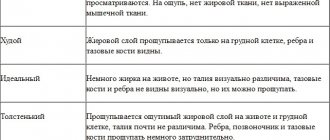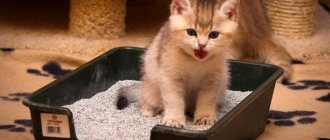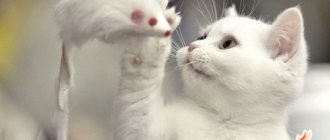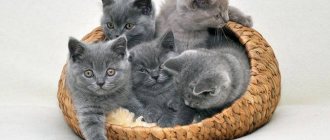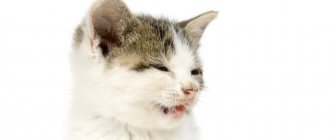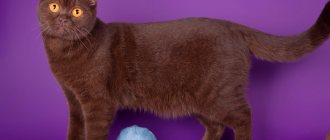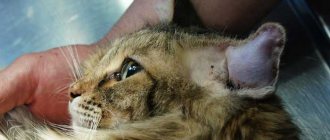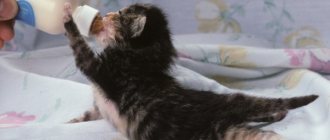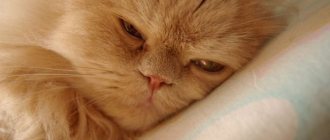Breed description, standards, appearance
British cats are massive animals, not without agility and grace.
Their calling card is their thick, plush coat and full, rounded cheeks. The breed standard was formed back in the 19th century and has remained virtually unchanged since then.
Dimensions and weight
British cats are medium to large in size. They have pronounced sexual dimorphism, so males are noticeably larger and heavier than females.
A British breed cat weighs between 3.5-6.5 kg. The cat's weight reaches 5.5-9 kg.
Anatomical characteristics
A typical representative of the breed should look consistent with the official description. The British Shorthair cat ideally has the following characteristics:
- The head is large, rounded with full cheeks and a weakly defined but noticeable stop. The nose is short and straight. The lobe forms a vertical line with the chin.
- The ears are neat, small, low set. Wide at the base, with rounded tips.
- The eyes are large and expressive. They have a rounded shape and wide set. Heterochromia is common in white British cats. Chinchilla-colored individuals come with lavender, green and blue eyes. The rest of the British people have orange irises.
- The body is massive, powerful with a deep chest, short muscular back and broad shoulders.
- The limbs are short, smooth, with rounded paws and strong, tight-fitting toes.
- The tail is thick, wide at the base, with a rounded tip. Moderately long.
Color and coat type
British cats are covered with short, elastic, dense fur that feels like plush. A thick undercoat is hidden under the shiny awn. The standard allows for several dozen variations in the color of British cats.
The most common colors found in the breed are:
- Plain (solid). This color of British cats implies a uniform color without any markings or spots. Rare solid colors include fawn and cinnamon. Particularly popular are gray (blue), beige, red, brown (chocolate), lilac, black and white British cats.
- Tortoiseshell. This color variant of British cats is a uniform combination of spots. It is unique to females. It is desirable for a British tortoiseshell cat's face to have a cream or red tint.
- Smoky. This coloring implies a contrast between the lightest possible undercoat and the darkest hair. It is most intense on the head, back and paws of the Briton.
- Bicolor. There are clearly defined white areas on the main background.
- Color point. This color of British cats is very similar to the Siamese. It has a combination of a white base color and red, chocolate or black markings.
- Tabby. Symmetrical spots and stripes are evenly distributed throughout the body of these British cats. That's why they are often compared to small tigers or leopards. The color is also called spotted, marbled or striped. On the forehead of a British cat of this color there is always a mark in the form of the letter “M”. The tabby color is characterized by spots on the belly, continuous rings on the chest and clear lines along the spine. This Briton has a striped tail and sides.
Possible breed defects
Exterior defects in the presence of which a British Shorthair cat may be recognized as not meeting the official standard:
- creases on the tail;
- eye color that does not harmonize with coat color;
- fuzzy jaw lines;
- extended body;
- polydactyly.
British kittens weight
This breed is large and massive, so British kittens are heavy. The weight of a newborn British kitten is about 130 g, and within 7 days their weight reaches 150 g. During this period of time, kittens actively feed on their mother's milk. The nutrition of a nursing cat plays an important role in the nutritional value of milk: its diet must be additionally fortified, so the mother of the kittens is fed specialized food or natural food with added vitamins.
Table 2. Kitten weight at different age periods
| Age | Cat weight | Kitty weight |
| Newborn | 70-140 g | 60-140 g |
| 1 Week | 240-260 g | 110-250 g |
| 2 weeks | 340-400 g | 150-360 g |
| 3 weeks | 400-630 g | 210-420 g |
| 4 weeks (month) | 550-740 g | 250-600 g |
| 2 months | 1-1.7 kg | 450-900 g |
| 3 months | 1.5-2.5 kg | 1.5 kg |
| 4 months | 2.1-3.9 kg | 1.7-2.4 kg |
| 5 months | 2.6-4.3 kg | 2.2-2.9 kg |
| 6 months | 3-5.4 kg | 2.3-3.6 kg |
| 7 months | 3.3-5.6 kg | 2.4-3.9 kg |
| 8 months | 3.5-6 kg | 2.5-4.1 kg |
| 9 months | 3.8-6.4 kg | 2.5-4.3 kg |
| 10 months | 4.1-6.7 kg | 2.5-4.4 kg |
| 11 months | 4.3-6.8 kg | 2.5-4.5 kg |
| 12 months (year) | 4.5-7 kg | 2.5-4.6 kg |
British kittens have quite a large body weight
Description of the breed
The British head has a round, regular shape with pronounced rump or cheeks. The nose is short, but smooth and wide. The ears are small, there are two types - slightly rounded, widely spaced and drooping at the tips to the bottom - fold-eared breed. Both types of ears have a wide base. The eyes are quite large, round in shape, widely set, the color is mostly rich golden.
The body of purebred British is muscular, with a wide chest and back, the animal is quite strong and agile. The tail is of medium size in thickness and length; it cannot be called thin and long. In terms of weight category, adult cats are somewhat heavier than cats: males weigh about 5-8 kg, females are smaller - from 4 to 6 kg.
Based on the type of coat, they are distinguished: long-haired and short-haired, but both types have an average length, there is no very noticeable difference - some have wool that is fluffier and longer, smooth, without curls, while others have short, straight, denser hair.
The coat color is even and uniform throughout the body. There are more than thirty varieties of color variations: red, white, gray, cream, black, combining several shades (gray, pink and gray), marble, gray-blue.
The character of the British is characterized by waywardness, partly even touchiness; they are proud and independent.
Video: Children at the zoo. The funniest moments!
Children between the ages of three and six years should first be seated comfortably before being allowed to pet or hold the cat. Otherwise, the child may drop it, or get hurt, especially the cat breaks out and scratches, squirming in their hands.
Babies who are just learning to walk may have their own problems interacting with cats. Little children love to pet cats, and it brings mutual pleasure to both of them. But in any case, one of the adults must be present nearby. If a child accidentally steps on or lies on the cat, or starts tugging on its fur or pulling its tail, the cat may display its aggressive, predatory nature. In pain, the animal can calmly scratch or bite the child. Very young children, up to two years old, have a habit of unexpectedly waving their arms, grabbing various objects, screaming, which, in turn, will scare the kitten, and it may behave inappropriately.
It is imperative to explain and show children several times how to properly hold a cat in your arms, how to stroke it, what is prohibited to do, in general, how to behave correctly when communicating with an animal.
The correct relationship between a child and a little friend is very important for the psyche of a pet. After all, you have a desire for your kitten to eventually grow into an intelligent and well-mannered cat.
First of all, communication security
Pets such as cats can be carriers of infectious diseases that are transmitted to humans from animals. Among such diseases are toxoplasmosis and inflammation of the peritoneum. Children are most at risk because they have a habit of putting their fingers and various foreign objects into their mouths.
Obligatory supervision is subject to the child's access to the cat's food, and vice versa, the cat to the children's food. It is also undesirable for him to lick a child's face so that he does not put the cat or dirty hands into his mouth. And make sure that the child washes his hands with soap after playing with the cat.
Small children should never be allowed near the cat's litter box. Cat waste should be removed immediately, especially if it appears in a children's play area. After this process, you should not forget to wash your hands with soap. Periodically, once every six months, give the cat anthelmintic medications.
Instill in your children the habit of asking permission before petting someone else's dog or cat. After all, many animals outside your home can be carriers of various diseases. And children can get infected from untrustworthy animals, thanks to their habits of putting everything in their mouths.
Having a cat in the house brings joy not only to the baby, but to the whole family. Thanks to your sensitive advice and gentle guidance, your child will gain the skills to protect his pet as a weaker living creature.
We should not forget that the cat is also a member of the family, and it requires appropriate treatment.
If you teach your children to respect all living beings, then when they grow up, the whole world may become a little kinder.
Attention, TODAY only!
Similar
Character
British cats are incredibly friendly. They are calm and balanced. Fold-eared cats are not at all characterized by emotional swings and typical cat hysteria. They do not show aggression and always “maintain neutrality.” Fold cats have a stable character.
These cats are especially attached to the house and owner. The British Fold cat easily becomes attached to a person, is friendly with everyone, carefully monitors the mood of its owners and adapts to it. They are loyal but not intrusive
The British will never deliberately attract the attention of the owner, distract him from business, jump on his lap or play pranks in any other way, since they are above such behavior. Typical representatives of the English aristocracy
If you need a smart, picky cat, then the British Fold is the perfect find! These animals are easy to train with basic training. It will not be difficult to accustom them to a tray or scratching post. These pets learn the rules of living in the house on the fly. Fold-eared kittens can even be weaned from climbing curtains. However, the owner of a representative of this breed must remember that unreasonable aggression and rudeness on his part can intimidate the animal, then the British Fold cat will begin to be afraid of people or show aggression.
Features of behavior
- Often representatives of this breed take a “column” position - they sit on their hind legs and straighten their back. It may seem like this is a British Fold cat posing for a photo, but in fact the reason lies in the physiological structure. This stance is necessary to stretch the spine.
- The British are very fond of small children and elderly people. Also, the presence of other animals in the house, including dogs, is not a problem for them. Folds get along well with everyone. Since they live quietly with dogs, these two pets often live in the same house together.
- Most British Folds are afraid of heights. This is explained by the specifics of the vestibular apparatus. Therefore, the owner of this cat does not have to worry about it jumping from the cabinet to the table, etc.
Beauty and purity
Caring for British kittens involves mandatory hygiene procedures:
- Combing. Caring for British kittens includes weekly brushing in winter and as needed in summer. You need a metal comb for the undercoat and a small brush for the coat. Cats are scratched according to fur growth and in the opposite direction. Animals quickly get used to the procedure and enjoy it.
- Bathing. It is believed that the British need bathing only after anti-parasitic treatment or if the pet is very dirty. You can use dry shampoo. However, some cats love water and are not afraid to play in it.
- Cat manicure. Mandatory procedure every 2 weeks, starting from 3 months of age. You need special guillotine scissors. When trimming a claw, you should not touch the blood vessels - they are clearly visible in the light.
- Examination of ears and eyes. Particular care for British kittens includes a weekly examination of the ears: they should be free of dirt, odor, and pus. The ears should be cleaned with liquids prescribed by the veterinarian. Also, babies under 5 months often have watery eyes. This goes away with the development of the respiratory system, but you can clean the eyes with damp cotton pads.
Your kitten should have its nails trimmed every two weeks.
Video: CATS, DOGS AND CHILDREN!!! Cats And Dogs
According to statistics, adults who grew up with pets are more sociable, kind and loyal to the people around them. And, as a rule, they subsequently also get a pet, because it is difficult to imagine life without animals.
According to research results, the proximity of a cat or dog and a child strengthens the baby’s immune system, forces the child’s body to more actively fight diseases, and increases the level of resistance to various infections. The presence of a cat in the house is highly desirable for a child.
For children who can already walk, a cat or dog will be a kind of teaching aid. Supervising and caring for a pet, caring for it, develops in a child such character traits as responsibility, kindness, and self-confidence. The child also develops comprehensively - fine motor skills and sensory skills are formed, logical thinking and observation skills develop. Physical development is also promoted by running and crawling while playing with a kitten. During such games, the child experiences positive emotions, and, caring for his little friend and his needs, gets involved in work.
Only by living in the same house will your child learn what it takes to maintain the trust and affection of a little Friend
He will understand that it is necessary to take many precautions, be attentive, do not disturb him during feeding, do not wake him up again, let him lead his cat life, do not dress him in toy clothes, do not drag the whole house by his tail, etc.
Never!
Never take a cat as a living toy for your own child. In this case, the exact opposite effect awaits you - the baby will get used to treating all living beings frivolously.
Parents are often afraid that their child may be allergic to animal fur. Consult your pediatrician. If a child has a tendency to allergies, then you should take this issue seriously. But however, according to scientists, children who grew up with animals have the least tendency to allergies.
It is not recommended to buy a cat for your children if you, or your other half, do not like animals. After all, the entire burden of caring for the cat will fall on one of the parents. And this responsibility of care cannot be passed on to children. If they become interested in new things and problems, they may forget to feed or stop caring for the cat’s fur.
Under no circumstances should you give a cat to the children of your acquaintances and friends without the prior consent of the parents. It is likely that there are reasons unknown to you that do not allow you to have a pet.
No violence!
It is extremely important to exclude mistreatment of a pet, which stems from ignorance of how to properly treat a cat. Also, poor treatment of a pet may result from carelessness or from a child’s misconception about pleasure. It is imperative to make it clear to the child that they need to treat their smaller brothers the same way they would like to be treated themselves.
And then give a clear example of such behavior. But among children, conscious cruelty towards animals is sometimes encountered. This is usually common among those children who have a bad relationship with their parents and who are treated poorly.
First moult and grooming
A kitten's first shedding occurs at seven or eight months of age. During the week, the kitten should be carefully combed every day with a special comb, running through the fur with massage movements. After this procedure, you can walk over the fur with your hand in a wet rubber glove, thus collecting the remaining fur. Subsequent molting occurs on an individual basis, depending on many factors - vitamin deficiency, allergic reactions, existing diseases, age-related and hormonal changes, and the use of inappropriate bathing products.
Regular grooming of the British dog's coat with special combs will preserve the beauty of the coat.
You need to groom your pet regularly:
- weekly brushing will bring many benefits to your pet. Firstly, this procedure will rid the cat of dead skin particles and fur hairs, which means that when licking, less of them will end up in the stomach. Secondly, regular brushing gives the animal a healthy and well-groomed appearance;
- if you accustom your kitten to water procedures from an early age, then bathing can become one of your pet’s favorite activities, which can be used both when soiled and for preventive measures;
- Careful trimming of the claws will rid the pet of the rough, keratinized part, which flakes off over time, causing the claws to begin to cling and cause discomfort to the cat. The procedure is short, only a couple of times a month. The haircut is carried out with special scissors, carefully so as not to damage the blood vessel;
- regular preventive examination of the auricle and organs of vision, when the cat’s ears are cleaned of wax accumulation, and the eyes are wiped with black tea infusion or eye drops.
From an early age, a kitten needs to be accustomed to the necessary procedures, then he will calmly endure them and even enjoy them
How to brush British cats?
Before purchasing a British kitten, you should buy special combs at a pet store. To care for your pet you will need:
- a comb with metal teeth with rounded ends so as not to injure the animal’s skin. Needed for primary combing of wool of any length in the direction from head to tail according to hair growth;
- comb with massage effect. Stimulates blood circulation, provides beautiful fur for your pet by combing out dead skin particles and dead hairs. You need to comb your pet with such a comb carefully so as not to damage the delicate undercoat;
- rubber brush or glove. Helps complete your pet's grooming routine. With the help of such a brush you can remove remaining hairs from the surface of the coat after active combing.
A variety of pet grooming products to choose from allows you to keep your cat's coat healthy and beautiful.
Bathing
The first bath of a kitten should be careful and not earlier than one month of age, so as not to scare the baby and not instill a negative impression of the procedure. It is better to teach the kitten to bathe in a playful way, touching the kitten with wet hands, and then gently moistening the baby’s fur with a few drops of warm water. This way, the kitten won’t get scared and won’t start to struggle, and the water, rolling off the fur, will attract attention and interest.
Gradually, with the help of play, the kitten will get used to the water and will allow its body to be completely wet, while you can also gradually begin to use special shampoos that do not have a strong odor. The only exception can be shampoos against parasites, the pungent smell of which can scare away the “British”. Bathing a pet kept in an apartment should not be done more than once every two months, unless treatment or severe contamination of the animal forces it to be done more often.
What do you need to know? The shampoo should be selected based on the length of your pet’s coat and its color, as some products are designed to enhance the color of the animal’s coat.
A kitten's first bath should be no earlier than one month of age.
Bathing stages:
- fill the container with water, adjusting its temperature (about 30 °C);
- pour a special shampoo into the water that suits your pet;
- place the cat in a container with soapy water and gently, massaging the fur, wet the cat’s body;
- rinse off the product with clean warm water, being careful not to get it into your ears, they are very sensitive;
- After bathing, wrap the cat in a dry towel to thoroughly dry the wet fur;
- Place your pet in a warm, draft-free room.
If you gradually accustom your kitten to water procedures, then over time he will enjoy the process and will not be capricious.
Difference between British Shorthair and Longhair
The British, like girls, are different. And their character depends on the variety.
A breed such as the British Shorthair cat has a very specific and ambiguous character. Depending on your mood, circumstances, your behavior and amount of attention, your pet may behave differently. If you anger an animal, this does not mean that you will be bitten right now. However, he has a good memory. And they will be offended by the owner for a long time
Therefore, it is important not to forget the main rule - the key to the heart of a British Shorthair is love and affection.
But the British Longhair cat has a much more flexible character than one with short hair. They are like heaven and earth. The long-haired British cat gets along with people and dogs in the house, will not try to eat your hamster or parrot, and will be friendly with you.
Toilet training
Adult British cats know very well where to go to the toilet. If they were raised correctly, then they will not mark their living space. When the kitten is very small, it will need to be trained to use a litter tray. As a rule, the previous owners have already taken care of this, but there are still situations when the breeder did not teach him to go to the toilet in a certain place, or the kitten forgot everything due to stress.
It is recommended that after eating, take the Briton to the tray and let him dig in it. Sometimes kittens taste stones, and this can be considered normal.
It is important for the baby to sniff everything and understand what exactly is in front of him.
You may have to take him to this place several times if the British kitten does not learn everything he needs the first time. It is worth being patient and also asking the breeder what kind of filler he used. In most cases, there are no problems with place training.
It is important to clean the toilet on time and not let it become dirty. The British kitten has a love of cleanliness, so he may avoid dirty places.
Power change
If you suddenly change the diet, you can get diarrhea in a kitten at 4 months. Therefore, you should not risk the life and health of a Briton by rushing to switch to another type of food, but gradually introduce him to food. Gradually increase the amount of new food when you feed your baby, while decreasing the amount of old food.
A meat diet is a bad option, so do not give your pet only meat at 4 months. Although they are considered carnivores, they remain omnivores, eating both meat and vegetables equally. Therefore, the diet must be balanced.
Siamese
Siamese are called dogs in cats' skin. This breed has an interesting feature - its voice: Siamese are able to change the pitch and tone of sound due to the structure of the vocal cords. They need physical contact, so they are sociable and playful.
This is a good friend for children, because the Siamese cat can be trained, it loves active movements and bustle. If a Siamese takes a child under his wing, he will protect and love him until the end of his days.
The Siamese have no equal in their ability to achieve their goals, even the most mischievous ones. They love to jump and move around on top, so a play area with high platforms should be made for them in the apartment.
It is believed that Siamese cats are vindictive and take revenge for insults, but this is a myth, because excellent long-term memory is characteristic of all cats: they are able to remember throughout their lives what impressed them.
A short-haired Siamese only needs to be brushed occasionally; it can be taught to swim from childhood - these cats love to swim in warm water.
Long-haired varieties of Siamese are the Balinese and Burmese cats.
Pros and cons of the breed
Breeders and fans of this breed will tell you unequivocally: this breed has no shortcomings. Perhaps the only negative is heavy molting in the off-season. If you brush your pet regularly, this deficiency will be minimized.
All other features of the breed are solid advantages:
- British kittens are affectionate, well trained and unforgiving.
- Cats are playful and cheerful. At the same time, they cannot be deprived of their self-esteem and peculiar aristocratic charm.
- Attachment to owners combined with independence. If he sees that the owner has no time for him, he will not impose himself. A cat is an excellent companion, but also tolerates loneliness well.
- Good attitude towards children and other animals.
The British Shorthair is a versatile breed. These cats will get along in any family. Their care is minimal: you just need to feed them properly, walk them, and monitor the condition of their claws and fur. The British belong to the category of “long-livers”: under adequate conditions they live up to 20 years. But the animal becomes truly adult only at 3 years of age.
How and what to feed
To avoid the obesity characteristic of this breed, you should follow some rules when feeding and caring for British kittens:
- Feeding with natural food. Having decided to limit your cat's diet to natural products, you must remember that cats cannot be given homemade food!
Boiled fish can be given to kittens once a week.
It is not recommended to give to animals:
- milk after 3 months of age;
- pork;
- raw turkey, chicken, beef;
- raw fish.
Cat food includes frozen and boiled meat, except pork, raw eggs, cottage cheese, sour cream, kefir, boiled vegetables, porridge, to which vegetable oil is added. Boiled fish can be given once a week.
Royal Canine is vet approved
To properly care for a British Fold kitten, feeding should be regular, at the same time. Cat meals must be prepared fresh daily.
Your pet's diet should contain vitamins, proteins, fats, and definitely calcium.
- Included in the proper care and nutrition of a British kitten is ready-made food. There are lines of industrial feeds containing all the substances an animal needs, including those approved by veterinarians:
- Royal Canine;
- Hill's;
- Iams;
- Sheba.
Ready-made food can be dry or canned in the form of pates or pieces in jelly.
Advice! To make it convenient for your pet to eat, you need wide, flat bowls. You can put a fountain bowl for water.
